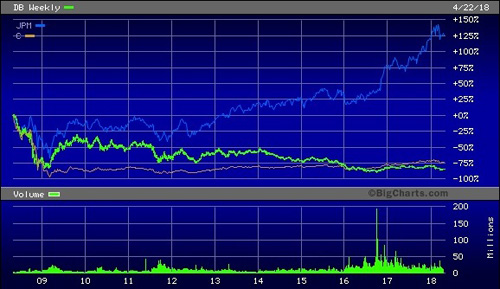Courtesy of Pam Martens

Deutsche Bank Chart (Green Line) Versus Citigroup (Orange Line) and JPMorgan Chase (Blue Line) Since 2008
By Pam Martens and Russ Martens: April 26, 2018
There is a great deal of hand-wringing in the U.S. media today over the plight of Deutsche Bank, the big German financial firm that has a hefty presence on Wall Street. Its first-quarter net profit slumped by 79 percent, it replaced its CEO of less than three years, John Cryan, this month with new CEO Christian Sewing whose game plan revolves around “painful” cuts.
On September 15, 2008, a key moment in the 2008 financial collapse on Wall Street when Lehman Brothers filed bankruptcy, Merrill Lynch was forced into the arms of Bank of America and Citigroup teetered toward insolvency, Deutsche Bank’s shares closed the day at $58.80 (equivalent price adjusted for a subsequent stock split). Yesterday, its shares closed at $14.60 on the New York Stock Exchange. Not only has it not recovered from the financial crash but it’s losing ground. Its shares are down a dramatic 21 percent in just the past 12 months.
With so much attention on Deutsche Bank’s woes, it’s curious that so little has been written about our own U.S. problem child – Citigroup (although we have certainly tried to make up for that here at Wall Street On Parade).
In 1998, with much media fanfare and cheerleading from the editorial page of the New York Times (for which it has since apologized) Citicorp CEO John Reed and Travelers Group CEO Sandy Weill announced they were merging the two firms. Citicorp at the time was the parent of the FDIC-insured Citibank while Travelers Group owned insurance companies, investment bank Salomon Brothers and the large retail brokerage firm, Smith Barney. At the time, the deal was in violation of the Glass-Steagall Act, the Depression era Federal law which barred firms that were primarily engaged in underwriting securities to affiliate with insured banks. The Bill Clinton administration would obligingly repeal the Glass-Steagall Act the year after the Citigroup merger and Clinton’s Treasury Secretary, Robert Rubin, would go on to make over $120 million sitting on the Board of the dysfunctional Citigroup over the next decade.
…



